The major installation work Heritage (illustrated), a ‘last paradise’ inspired by Queensland’s North Stradbroke Island, moves visitors with the symbolism behind the work.
On first encountering Cai Guo-Qiang’s 2013 installation, many visitors gasp in awe and surprise, a visceral response that is at once sensory and emotional. While many contemporary works of art evoke a sense of wonder, be it through scale, technical virtuosity, or other evidence of extraordinarily intensive labour, such a genuine feeling is difficult to orchestrate. Cai’s work displays all three of these attributes, and contains an additional element: a powerful aura of stillness and resolve that the artist has described as a ‘religious solemnity’, which may explain this deep response in people.
Cai Guo-Qiang ‘Heritage’ 2013
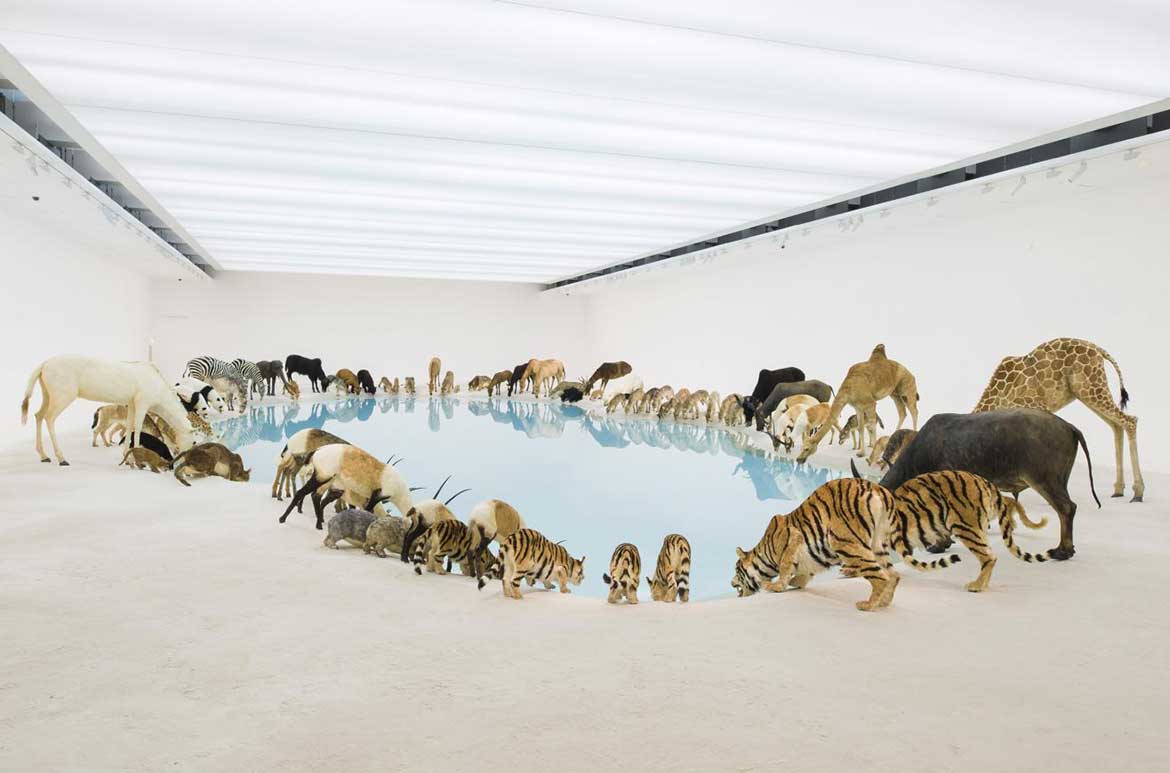
Heritage offers an indelible, if impossible, image of the natural world in a moment of perfect harmony, while also gently evoking a mood of crisis, comprising 99 replicas of animals (carved from polystyrene and covered in goat hide) that bow to drink from a vast blue pool surrounded by white sand. There are uncanny versions of beasts from across the world, from tigers, giraffes and zebras to polar bears and chimpanzees, to wombats and kangaroos. The work was initially inspired by an image that came to the artist after travelling to North Stradbroke Island (Minjerribah), off the coast of Brisbane, in 2011.
The pristine environment of the work embodies Cai’s perception of Queensland as a kind of ‘last paradise’, where the woes plaguing the rest of the human and natural worlds are yet to take hold. The allegory that Heritage creates of a harmonious multicultural society within a unique and beautiful landscape is understood as an ideal, its tensions and fractures lying just below the surface.
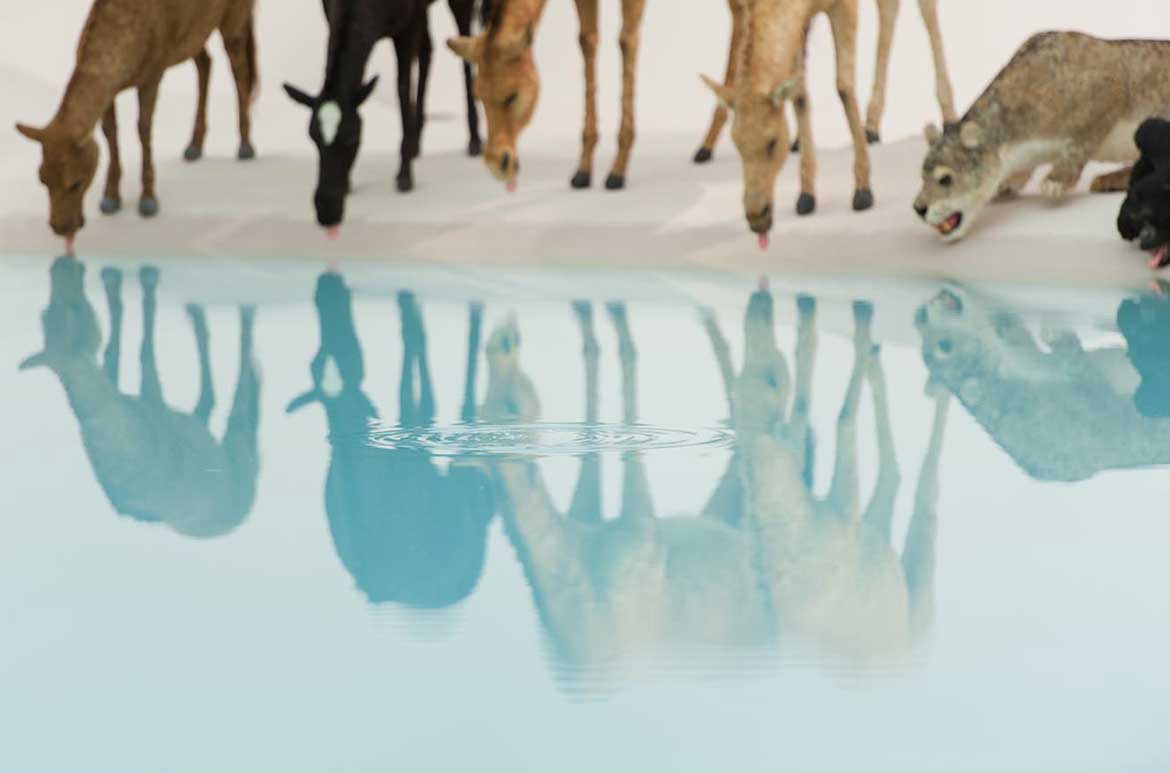

The only movement is a single drip of water that falls from the ceiling into the pool, its slight disturbance reminding us that this conviviality cannot last. Other questions begin to arise: what has brought these unlikely animals together? Is this the only place they can find sustenance and peace? What would happen if they lifted their heads?
While best known for dramatic explosion events, in which gunpowder and fireworks are used to create ritualistic spectacles in both remote and urban sites, Cai has also created a number of elaborate installations throughout his career. They reflect his early training in theatre design and performance: Cai travelled China with a propaganda troupe during the Cultural Revolution era of the early 1970s and studied at the Shanghai Theatre Academy in the 1980s. These experiences have clearly informed his approach to installation, ‘instilling them with particular temporal and spatial dynamism and performance sensibility’.1
An ongoing motif is the use of animals, configured in narrative tableaus that convey the artist’s concerns for humanity’s estrangement from nature, and its inexhaustible tendency to inflict violence on others.
Heritage is one of the most ambitious commissions that the Gallery has undertaken, from one of the world’s most acclaimed contemporary artists. the work augments the major gunpowder drawing Cai created for ‘The 2nd Asia Pacific Triennial of Contemporary Art’ in 1996, and adds significantly to the group of important installations in the Collection by leading Chinese artists including Huang Yong Ping, Ai Weiwei and Xu Bing.
Like these artists, Cai Guo-Qiang draws on Chinese philosophy, aesthetics and craftsmanship in the conception and production of his works, yet he has always also looked outward — beyond borders, cultural differences, even beyond Earth, as in his ‘Projects for Extraterrestrials’ series. His work strives to synthesise and make visible to us the unseen forces of history, memory and culture that shape our lives, wherever we may live, and his ability to connect is no better expressed than in that first gasp of wonder.
Russell Storer is former Curatorial Manager, Asian and Pacific Art, QAGOMA
Endnote
1 Mónica Ramírez-Montigut, ‘Installations’, in Cai Guo-Qiang: I Want to Believe [exhibition catalogue], Guggenheim Museum, New York, 2008, p.190.
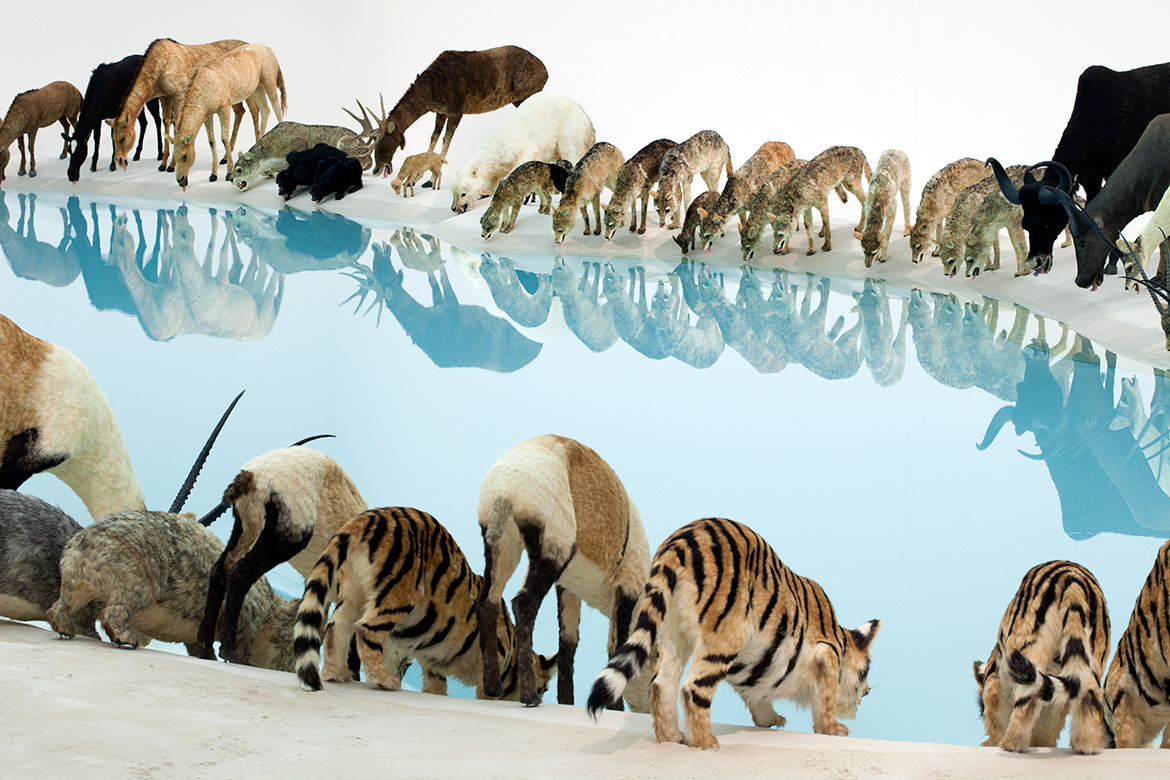
#QAGOMA
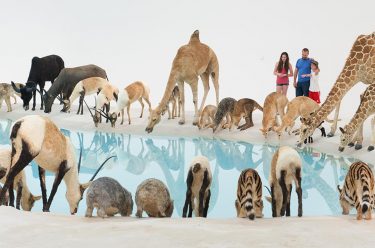
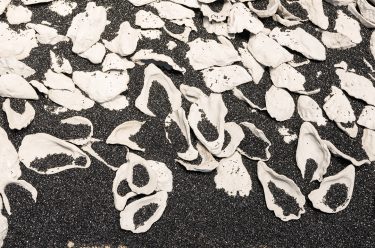
What does the drop of water mean
Hi Lily. The single drip breaks the surface of the water and interrupts the stillness of the room and is also a pointer to questions that activate this strange and peaceful tableau: what brought this menagerie together, and how can the predators and prey in this gathering relate to each other? If ‘Heritage’ portrays the ‘perfect paradise’, does it also symbolise Earth’s sorrow? Regards QAGOMA
When did this solo exhibition run from?
Hi Mary, the exhibition ‘Cai Guo-Qiang: Falling Back to Earth’ was at GOMA from 23 November 2013 – 12 May 2014, however you have the chance to view ‘Heritage’ again this Summer when the exhibition ‘Water’ opens at GOMA from 7 December 2019 – 26 April 2020 https://www.qagoma.qld.gov.au/whats-on/exhibitions/water Hope you can make it. Regards QAGOMA
Why Are there so many animals?
Hi Lebron, the use of 99 animals is significant, with 9 and 99 used repeatedly in Cai’s work, it represents an ‘incomplete’ rather than a round number, suggesting something more to come, as well as referencing Chinese numerology, in which the number nine is highly auspicious and means long-lasting. In all presentations of ‘Heritage’, the artist indicated that smaller groupings of animals can be composed in multiples of nine.
Has GOMA purchased this exhibition?
Hi Kay, ‘Heritage’ is an artwork the Galley purchased for the Collection in 2013 with the support of the Josephine Ulrick and Win Schubert Diversity Foundation. It was recently on display in the ‘Water’ exhibition at GOMA.
Hi, does the drip of water actually fall from the ceiling? Or is it just ripples in the “water”? Also, thanks for your information, it really helped with my project.
Hi. The water dripped from the ceiling, glad we could be of assistance :)
Hi,
what are the animals made out of?
regards.
Hi Cooper. This blog explains the manufacture of the imitation animals https://blog.qagoma.qld.gov.au/commissioning-heritage-an-installation-by-cai-guo-qiang Regards QAGOMA
how long did the artwork take to make?
Hi Natalia. Thanks for your interest. Over a period of six years from 2008, QAGOMA and artist Cai Guo-Qiang developed and realised ‘Heritage’ 2013. You can read more at https://blog.qagoma.qld.gov.au/commissioning-heritage-an-installation-by-cai-guo-qiang. Regards QAGOMA
What form and exact subject matter has the artist used? Is the animal symbolic/representing something?
What materials and techniques has the artist used to make the work?
What signs and symbols has the artist selected and put into this work?
What compositional arrangement has the artist used?
What colour, shape, texture, line, repetition, contrast, dominance, unity, focal point, movement, tone, direction…. has the artist used in this work?
What artmaking style did the artist use to make the work?
Does the scale of the work or exhibition location imply meaning?
What feelings or emotions (the deeply felt) has the artist tried to express in this work?
What personal experiences has the artist gone through that is reflected in this work?
What personal beliefs, values, interests does the artist have that is communicated in this work?
What does the artist feel towards/about the subject matter they are depicting in this work?
Hi Caroline, thanks for making contact, here is a link to all our blogs on ‘Heritage’, hopefully this will be able to help answer your numerous questions. The exhibition catalogue highlighting ‘Heritage’ is available for purchase at the QAGOMA Store https://qagoma.store/products/cai-guo-qiang-falling-back-to-earth alternatively you can make a time to view the publication in the QAGOMA Research Library https://www.qagoma.qld.gov.au/learn/library/. Regards QAGOMA
hello, this artwork really inspires me, and I have a few questions I was wondering you could and answer:
what are the dimensions of the artwork?
who is the artwork intended for?
what where critics responses or reactions to the artwork? what did the public say?
what influenced the artist?
thank you! hopefully you can reply soon, urgent!!
from, your big fan Gertrude
Hi Gertrude, have you had a change to look over all our blogs on ‘Heritage’? https://blog.qagoma.qld.gov.au/tag/heritage/ all your questions will be answered, for example Heritage covered 1104 m2 of floor space when display as 99 animals https://blog.qagoma.qld.gov.au/commissioning-heritage-an-installation-by-cai-guo-qiang/ etc and let Bob know they are not edible :) Regards QAGOMA
What is the importance of the water in the artwork?
Hi Joe. Heritage’s 99 animals from around the world congregate at a waterhole — a pristine, utopic installation. The concept was triggered by the artist’s visit to the pristine fresh water lakes on Stradbroke Island, particularly Bummeira (Brown Lake). The aim of the work is to present a poetic space with a sense of the Australian identity, symbolising the country’s diversity of culture and heritage but also a sense of a mythical paradise, the land of OZ where animals from all over the world can come together and drink, highlighting the interconnected fate of all of us who inhabit planet Earth. An incessant dripping of water at the centre of the pond and sound draws attention to the preciousness of water, the source of all life. More information is in our series of blogs at https://blog.qagoma.qld.gov.au/tag/heritage/
Did the public like this artwork? I feel as if it could be a bit controversial as the animals look so realistic. Not sure what the critics would have thought! If you know anything about this please get back to me. Hugs, Katie
Hi Kate. Here is a link to a series of reviews for the exhibition ‘Cai Quo-Giang: Falling Back to Earth’ of which ‘Heritage’ was first displayed https://www.google.com/search?q=cai+guo-qiang+falling+back+to+earth+reviews Many thanks for your interest. Regards QAGOMA